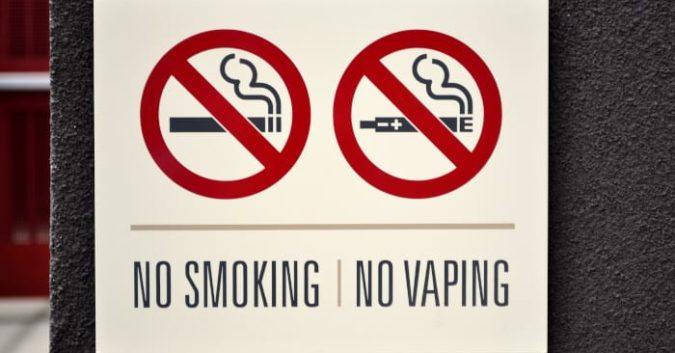In an effort to curb what has been described as a “youth vaping epidemic,” the Food and Drug Administration (FDA) will be announcing new and significant regulations regarding the sale of e-cigarettes. Soon – potentially this week – the FDA will prohibit convenience stores and gas stations from selling flavored e-cigarette products, which the administration believes are driving the spike in teen usage.
The ban targets vaporizers with pre-packaged flavor cartridges from manufacturers such as Juul, Blu, MarkTen XL, Logic, and Vuse.
Initially, the regulations will not include menthol, tobacco, or mint so as not to push adult vapers toward regular cigarettes, which are available in those flavors. Specialty tobacco and vape stores will still be allowed to carry flavors, as the FDA believes they are more stringent when it comes to carding customers. Online retailers will still be able to sell flavored e-cigarette cartridges, but they too will likely face new regulations concerning age-verification and “straw-man buyers” who re-sell their purchases illegally.
All of this is new territory for businesses and the FDA. The e-cigarette industry is young and has grown exponentially over the last few years. But with that growth, comes some questions: How much of this growth is taking place among young and underage users? How much should the FDA restrict the rights of businesses in order to follow their mandate to protect public health?
E-Cigarette Use Skyrocketing among Minors
Lobbyists for the e-cigarette industry, manufacturers, and retailers who stand to lose money are obviously not in favor of any limits on the freedom to sell a range of flavors to adult consumers. The troubling reality is that, under current regulation and enforcement, electronic cigarettes are flying off the shelves and into the pockets of teenagers at an alarming rate. The National Youth Tobacco Survey (NYTS) reported that in the last year, e-cigarette use skyrocketed by 77 percent among high schoolers and by nearly 50 percent among middle schoolers.
Why Are E-Cigarettes Dangerous?
There remain a lot of unknowns when it comes to the long-term safety of inhaling the chemical vapors that e-cigarettes generate. Supporters maintain that vaping is an important tool to help people quit smoking traditional cigarettes. Currently, however, no brand of e-cigarette is approved as a quit-smoking aid.
With the new regulations, FDA Commissioner Scott Gottlieb hopes to strike a healthier balance between the long-term health of our nation and the growth of its businesses. In an earlier statement about the rationale behind the regulations, Gottlieb wrote:
“I’ll be clear. The FDA won’t tolerate a whole generation of young people becoming addicted to nicotine as a tradeoff for enabling adults to have unfettered access to these same products.”
Over the past year, as the number of underage e-cigarette smokers has climbed, Gottlieb has pressured manufacturers and retailers to address the problem seriously. Unfortunately, in Gottlieb’s view, e-cigarette businesses have instead treated the issue like a “public relations challenge,” demonstrating a lack of understanding as to the devastating implications of a surge in teen nicotine use.
Are Flavored E-Cigs the New Joe Camel?
The dangers of traditional cigarettes have been known for decades, but that did not stop the R.J. Reynolds Tobacco Company from trying to attract young people to their cigarettes using the friendly cartoon character, Joe Camel. Internal memos revealed that Reynolds deliberately marketed their cigarettes to teenagers between the ages of 14- and 18-years-old, because those users would then be hooked for life. Getting tobacco in the hands of teens was crucial to the growth of their business.
Eventually, under enough public pressure, Joe Camel was dropped, but Reynolds continued to target that lucrative age-group. In the early 2000s, they launched a range of fruity and candy flavored cigarettes until they were stopped by the 2009 Family Smoking Prevention and Tobacco Control Act, which banned “cigarettes with characterizing flavors, except menthol and tobacco.” Until the vaping craze began, the number of young tobacco users had declined to its lowest point since records were kept.
With these new regulations, it seems that the FDA wants to stifle youth vaping with a strategy that had positive results on underage tobacco use. Since announcing the planned regulations in September, Gottlieb noted that manufacturers have started to change their tune, and he welcomes the constructive dialogue.
There are reports that Juul, the most popular brand of e-cigarette, is gearing to pull flavors from gas stations and convenience stores. But will this be enough? Gottlieb says that the FDA will “ensure that the companies making and selling these products are doing their part to reverse this epidemic.” Those that don’t, will be held accountable – and if these changes are not enough to halt the teen-vaping epidemic, Gottlieb promises that more regulations are on the horizon.
The FDA is holding a public hearing on December 5th to discuss youth e-cigarette use and treatment.
